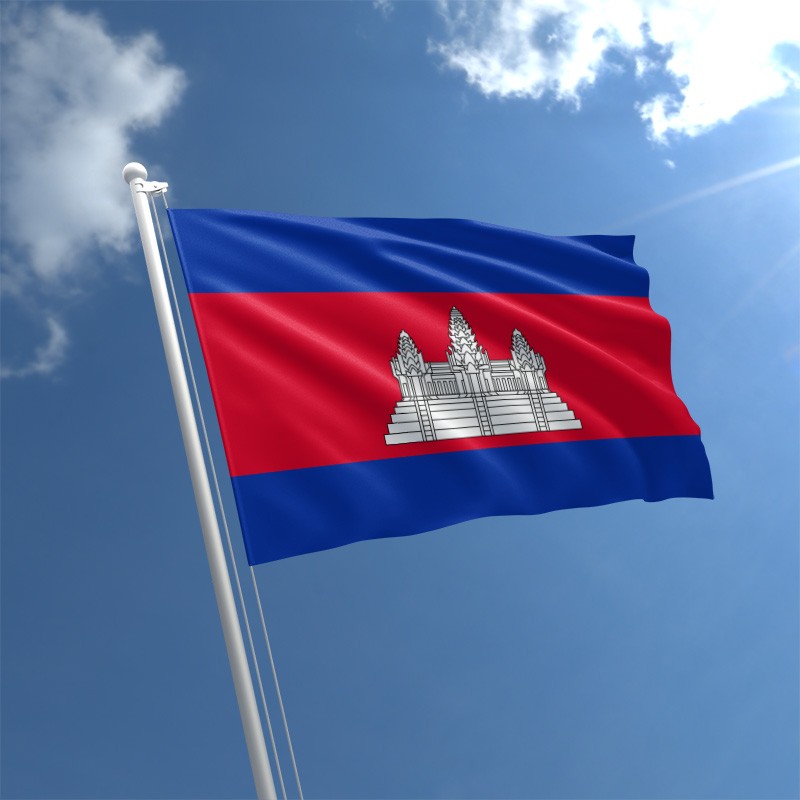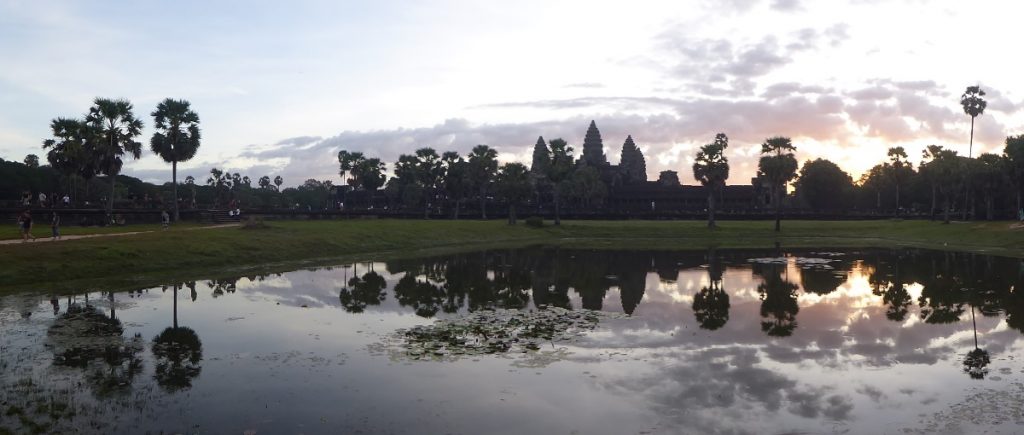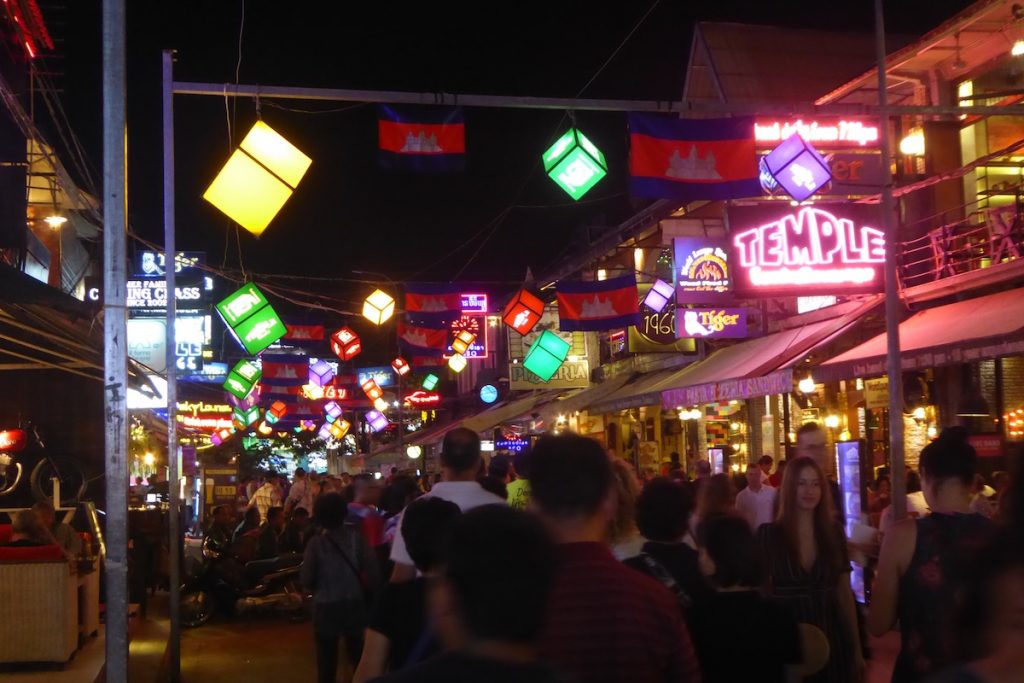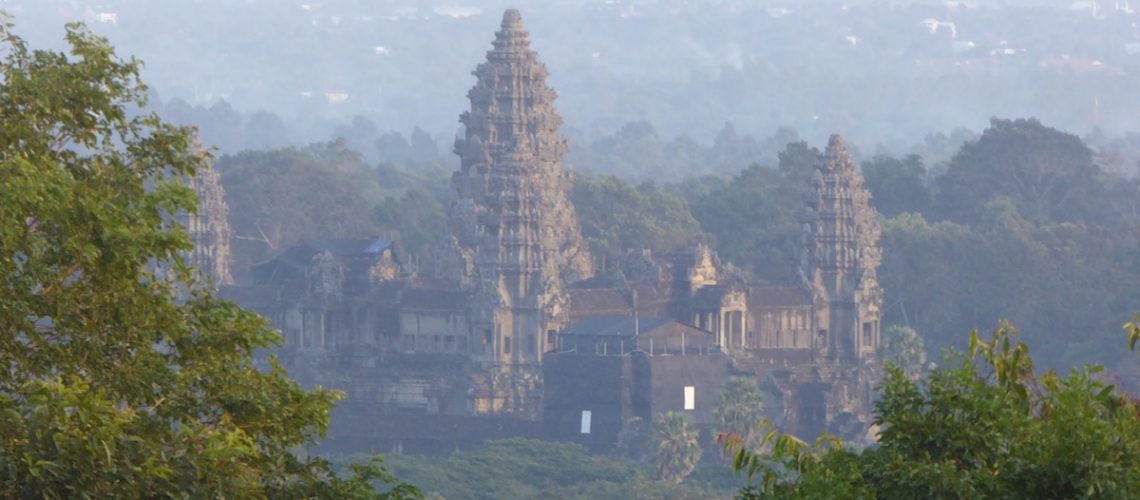Widely considered one of the man made wonders of the world, and one of the most visited sites in the world.
Angkor Wat itself is the largest religious building in the world, but it’s actually only one temple in an area of about 400 square kilometres containing myriad temples and the ancient capital of Cambodia’s Khmer Empire during the Angkorian period that covers more than 600 years from AD 802 to the 15th century.
If you’re not interested in the history, skip this bit….
The golden age or classical period saw unparalleled building at Angkor, and saw the construction not only of Angkor Wat itself, but of the walled city of Angkor Thom and many of the other temples that now form the itinerary for most visits to the area today. However it was also a time of turmoil and war, and the construction of the walled city itself is only due to the sacking of the previous wooden capital by the Chams (South Vietnamese) in 1177.
The reign of Suryavarman II (r 1112–52) saw the building of the now world famous Angkor Wat. The temple itself is dedicated to Vishnu and unusually faces west, a sign of death, leading to a theory that the temple was also intended as the mausoleum for the god-king himself. This temple signifies a high water mark of Khmer civilisation, but there were already signs of decline. Overpopulation and deforestation (yes, seems that it has been causing problems for centuries) may have led to the reservoirs and canals supporting the agriculture of the empire being overstretched and silting up. In addition, Suryavarman II himself was killed during a disastrous war with the Vietnamese.
Jayavarman VII (r 1181–1219) was responsible for rebuilding the Angkor capital, Angkor Thom, after the sacking by the Chams, but his reign saw a marked departure from the Hindu basis of previous kings to a more Buddhist religion. He continued in the trend of prodigious temple building though and gave us Bayon and Ta Prohm (of Tomb Raider fame) as well as a major programme of public work (roads, schools and hospitals) across the Empire.
After his death around 1219 the Khmer Empire went into decline, being finally sacked by the Thais in 1431 (for the second time) after which it was largely abandoned to religious devotees and the elements until it was ‘discovered’ by the French in the 1860s which unveiled its existence to the world although at the time it was an active religious site including a wealthy, working monastery replete with monks and slaves.

The temple complex is of such importance to the Cambodians that they actually have an image of it in the centre of their national flag.
Firstly, Angkor Wat and the other temples are quite awe inspiring, and well worth visiting. It’s impossible (the guide books say this, and it’s true for once) to even properly see one site in a day. We bought the three day pass (at $72 each) and after being around the temples for three days we’d seen a lot, were pretty well ‘temples out’ but still had loads of places that we hadn’t seen and others that could justify a second (or third) visit.
Angkor Wat is obviously a highlight of a visit. It was originally a Hindu temple dedicated to Lord Vishnu (it gradually turned into a Buddhist temple later on). Its design is meant to represent Mt. Meru, in Hindu mythology the home of the deities. It also adopts the later Khmer style of temple building with immense galleries surrounding the central complex.
To give you an idea of it’s size, the 3.6km outer wall sits inside a moat more that is more than 5 kilometres long. Inside the outer wall are three rectangular galleries, each raised above the next. At the centre is the heart of the structure. The central pyramid representing Mt. Meru with four smaller towers forming a square around it. The whole thing contains extensive bas reliefs and many of the walls are adorned with Apsaras (dancing women).
Getting up at 4:15 to catch a tuktuk to witness the sunrise is definitely worth it.

Other highlights for us were Bayon (the centre point of Angkor Thom)…
…and Banteay Srei (a small but beautiful temple set in the tranquil Cambodian countryside some 32km north east of Siem Reap.
Also worth a quick mention are Ta Prohm (obviously, as it featured in Tomb Raider)…
…and Banteay Samré (which was almost deserted, but more of that in a minute).

We stayed in Siem Reap. Siem Reap is now the second largest city in Cambodia and has grown around the tourist demands for visiting Angkor Wat. It has a new, and decent (even by western standards) airport, and countless places to stay ranging from backpacker hostels to guesthouses and luxury 5 star resort hotels. It has a central area with a vibrant nightlife (including a road called Pub Street), many restaurants and bars and several night markets.
It’s still actually a pretty nice place to stay. Our hotel (the Villa Siem Reap) was just over a 5 minute walk to the nightlife and the staff were extremely friendly and helpful. But overall it’s a pretty relaxed place to spend a few days. We found a nice bakery school serving pastries and coffee for breakfast (proceeds going back into running the school which was for disadvantaged women), some good local restaurants serving cheap and tasty Khmer food and we even found an Irish bar (without Guinness, the draught version of which is apparently unavailable in Cambodia) at which we watch some of the autumn international rugby.
It’s close to the Tonlé Sap lake, one of the biggest in SE Asia, where we went to see a floating village (actually a village on stilts) take a trip up the river and watch the sunset from the lake. To be honest, it wasn’t the most informative trip we went on. I’d expected to find out a bit more about how the people live and what they do to survive but it was interesting seeing the buildings and the people (it was Sunday so no school hence lots of kids running around). I did feel though, that even though they may still catch fish, their main source of income was us tourists and that they were using every opportunity (as we were shepherded from floating shop to restaurant) to sell us something and to earn a few quick dollars.
But it is busy in Siem Reap.
When you are in town you can’t walk more than 10 metres without being asked if you want a tuktuk or if you want to go to the temples or maybe you’d like a guide tomorrow. At times you really feel like telling them where to go. The best one, which did make me laugh, was on getting out of a tuktuk at our hotel, the guy in the one in front of where we’d parked, half turned as we got out and asked if we needed a tuktuk!!!! You have to admire their perseverance really.
And this brings me to a bit of a moral dilemma.
Before I go on, staying in Siem Reap was great, visiting the Angkor temples and the surrounding countryside is something I wouldn’t want to miss and (just like we’re finding in other parts of Cambodia and SE Asia) the people are really friendly and welcoming.
But how much is the area being affected by tourism?
Of all the places we’ve been to date, Angkor Wat is probably the easiest place to get to of anywhere. There’s an international airport, and as I’ve said, accommodation to suit any taste and budget. If the urge took you, you could pack some hand luggage and visit the site over a long weekend (as a Philippine family who we met on the Tonlé Sap trip had, I know their flight isn’t as long as from Europe though).
The result of this is that the main sites are packed. Seemingly all the time. When we went to watch the sunrise there were thousands of people there. At 5:30 in the morning. Trying to appreciate some of the fine carvings, or the general aura of the place was impossible due to selfies, loud groups of (often Chinese) tourists disturbing the peace, and just sheer volumes of people often in quite confined spaces.
At the sunrise, there was a constant babble of voices and if you were late to the party, instead of being able to stand in front of one of the reflection pools (the perfect unrise vantage points, you’d be 6 deep back in the crowds.
Some of our favourite moments were at the smaller temples, less crowded, where you could take time to look around, hear nature around you and not feel part of an endless train of people filing past one famous landmark or another.
While we were staying in Siem Reap it made me think back to our visit to Hampi. There are actually quite a few similarities between the two places. Both were the centre of a Hindu empire and are still considered as holy and sacred sites. They both cover a vast area and are made up of a multitude of temples, palaces, and public buildings. But away from the main Hampi Bazaar area (miniscule compared with Siem Reap) you can walk alone amongst many of the ruins. Even the places on the tourist routes are not overrun with anything other than lizards and troops of monkeys.
Yes, there was still hassle from tuktuk drivers, you get that everywhere (I think it’s an inherent part of their training), but often there was a quiet serenity that was hard to come by at Angkor. The occasion that really springs to mind was watching the sunset from the Hemakuta Hill overlooking the town. There were certainly dozens of people there, if not hundreds, but as the sun set and the music drifted up from the temple below there was a calmness. People there, enjoying the tranquility and reflecting on their thoughts.
Would Hampi be the same as Angkor if they built an international airport 10km away instead of having to undertake an all day train or bus journey to get there? I guess it probably would.
Angkor is well worth visiting, in spite of the crowds. The Cambodians are lovely people, it’s welcoming and it’s a spectacular place to see.
It did make me realise though what an amazing site Hampi is too, in some ways on a par with Angkor (in my opinion), and it also made me feel privileged to have seen it now. Just in case they do build an airport and it does get overrun with tourists because it becomes as easy to see as the Eiffel Tower.
Again, we took literally hundreds of photographs in and around the temples at Angkor.
If you’re not already bored by temples and want to see some more pictures then here’s a gallery with some more for you to enjoy.

4 thoughts on “Angkor Wat 🇰🇭”
The temples in and around Seam Reap are fantastic, especially Angkor Wat and Bateay Srei. I cannot imagine those places with that many tourists; in 1997 we were sometimes the only people around. I love the posts and photos and am so glad you’re having a wonderful time!
This is brilliant, feels like we are doing the tour with you.
Did you use a tour company?
You guys REALLY need to write a travel guide or get a series with the BBC!!
Just brilliant.
Thank you for sharing. X
Agree with Andy Davies you are both certainly very good was lovely reading Looking forward to hearing from you. Love xx